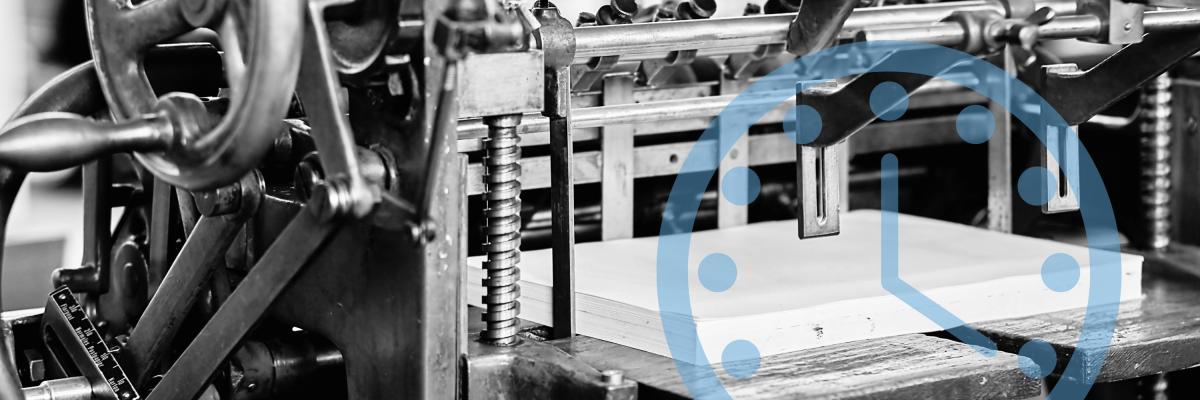
Did you know that one of the Founding Fathers of the United States worked as a printer? Or that some of the very first print impressions were made by cave people thousands of years ago?
From ancient cave art to the digital age, the story of printing is as old as human civilization itself. It has shaped the way we communicate, learn, and share knowledge. Because printing is at the heart of human culture, it’s necessary we learn about its evolution.
As experts in the printing industry, our team at STPT has created this timeline to help you explore the fascinating history of printing technology—from primitive hand stencils to the advanced printers we use today.
What Is Printing?
At its core, printing is the process of reproducing text and images onto a surface, like paper or fabric. It allows us to share information quickly and efficiently, making it one of the most powerful tools in human history. The most basic form of printing is stenciling, where pigment is applied over a template to create designs on another surface.
But printing has come a long way since then. Today, we have laser printers, digital presses, and even AI-powered printing technology that can create incredibly detailed and accurate prints in seconds. However, to truly appreciate these advancements, it’s important to understand where it all began.
Early Beginnings: From Cave Walls to Woodblocks
The First "Prints" in Human History
Long before paper and ink, humans were already experimenting with ways to reproduce images. Some of the earliest examples of printing can be traced back to prehistoric times, when ancient people used their hands as stencils. They would place their hands on cave walls and blow pigment over them, leaving a silhouette of the hand behind.

These simple, yet profound, stencils allowed early humans to communicate and express their identity long before written language existed.
The Birth of Printmaking Technology in China
The origins of organized printmaking technology can be traced back to China, around the 2nd century AD, where the earliest forms of printmaking were developed long before Gutenberg’s press.
One of the most significant techniques was xylography, also known as woodblock printing. This method involved carving images or text onto wooden blocks, applying ink, and pressing the blocks onto paper. It was primarily used to reproduce religious texts and intricate illustrations, enabling the spread of knowledge across Asia.
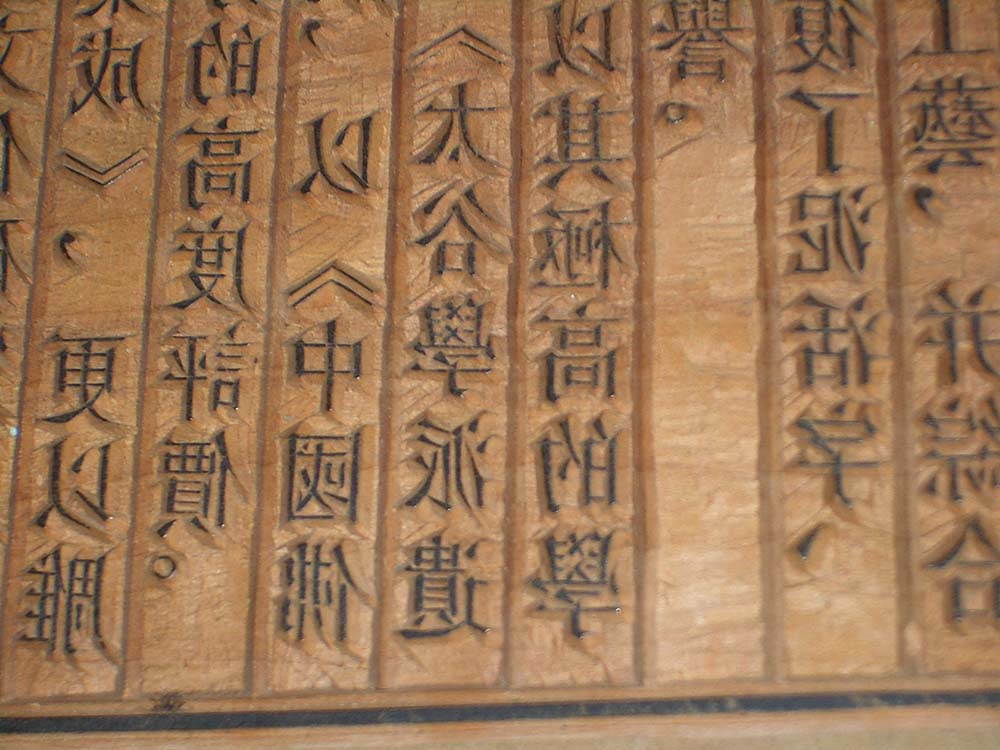
Xylography laid the groundwork for future printing methods and played a crucial role in making literature and art accessible to a broader audience. This technique is considered one of the oldest printmaking methods and was a precursor to the movable type system later used in Europe, which we will discuss briefly below.
Movable Type: A Game Changer
By the 11th century, another significant innovation came from China: movable type. Unlike woodblocks, which required an entire new block for each page, movable type used individual characters that could be rearranged and reused. This made printing more efficient and adaptable, laying the groundwork for future advances in printing technology.
The Printing Press: A Revolution in Communication
Gutenberg’s Breakthrough
If you’re like most Americans, then you probably remember your 9th grade history teacher telling you the printing press was the most important invention in human history—and they were right!
The invention of the printing press by Johannes Gutenberg around 1450 in Germany is often considered one of the most transformative events in human history.
Using a flatbed press and movable metal type, Gutenberg (the “Father of Printing”) was able to produce the first mass-printed book in the Western world: the Gutenberg Bible.
Below is a replica of Gutenberg's press from the Featherbed Alley Printshop Museum, Bermuda.
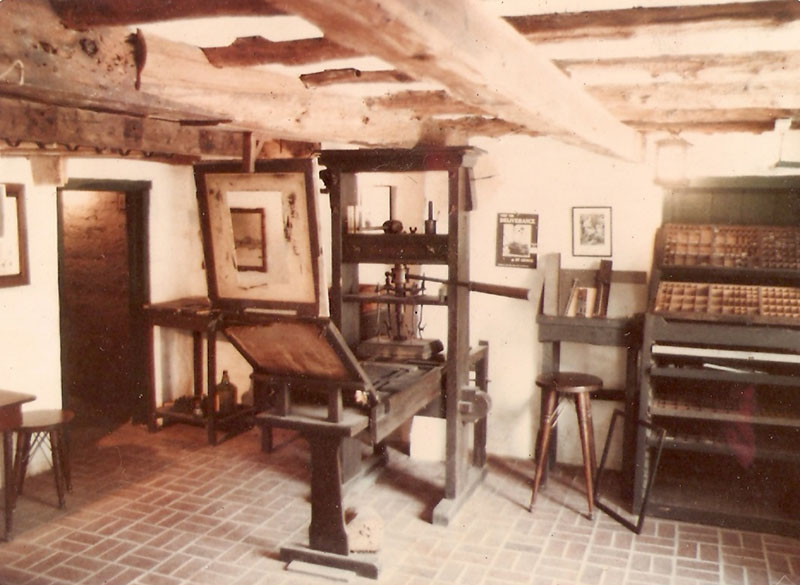
The Diamond Sutra: The Oldest Known Printed Book
While Gutenberg is often credited with bringing printing to the Western world, the oldest known printed book is actually the Diamond Sutra, a Buddhist text printed in China in 868 AD using woodblock printing. This shows how advanced and widespread print technology was in Asia long before it reached Europe.
What Happened When the Printing Press Was Invented?
Gutenberg’s printing press is the foundation of the modern educational system. Before its invention, copying texts by hand was slow, and only a few people had access to books. The printing press changed everything in the 15th century, allowing for the mass production of books and documents, which made these more accessible and affordable.
With the printing press, information could be shared quickly and widely. For the first time, news pamphlets were printed and read aloud in town squares, allowing people to hear about events happening far beyond their local communities. This rapid spread of information fueled movements like the Renaissance, which revived interest in ancient Greek and Roman texts and helped pull Europe out of the Dark Ages.
The printing press didn’t just impact education and culture—it created an entirely new industry. The demand for books, newspapers, and other printed materials grew rapidly, leading to the rise of the printing industry. This industry, in turn, supported other fields, like bookselling and publishing.
This was also the era when typography—the art and technique of arranging type—began to evolve. With new movable typefaces, printers could experiment with different designs and layouts, making books and pamphlets more visually engaging and easier to read.
Even some of history's most influential figures were involved in printing. For example, Benjamin Franklin, one of America's Founding Fathers, started his career as a printer's apprentice before becoming an inventor and revolutionary.
The Invention of the Modern Printer
The journey from the printing press to the modern printer began in 1938, when Chester Carlson invented the xerographic process.
This method, which uses static electricity to transfer an image onto paper, became the basis for all modern copiers and laser printers. The picture below is the first ever photocopy/image printed using Carlson's xerography technique.
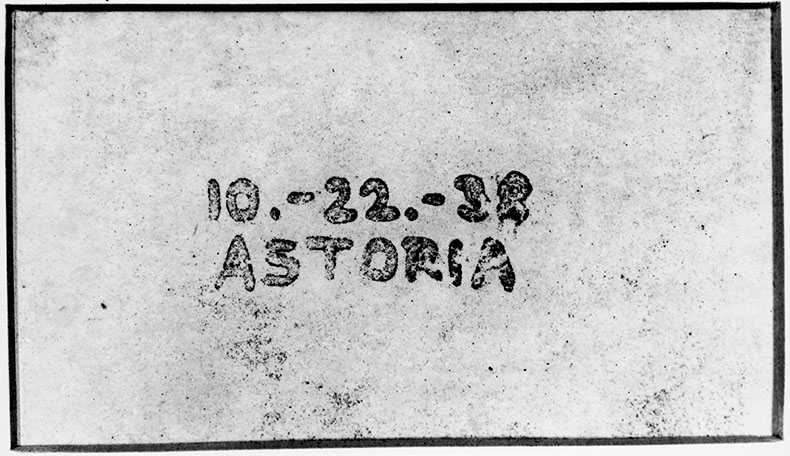
Carlson’s invention laid the groundwork for the Xerox Corporation and the creation of the first photocopier. In 1959, Xerox introduced the Xerox 914, the world’s first automatic plain-paper copier, revolutionizing how businesses handled documents.
This breakthrough in photocopying technology also paved the way for the development of the laser printer. In 1977, Gary Starkweather developed the Xerox 9700, the first commercial laser printer.
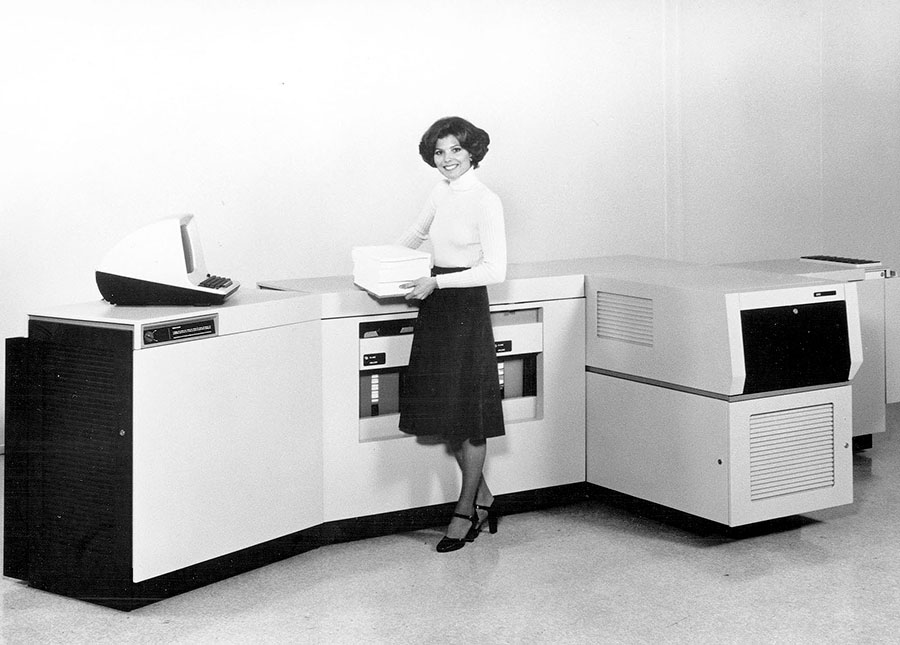
Laser printers quickly became popular in offices because they were fast, reliable, and produced high-quality prints. Soon enough other companies like IBM and HP joined the race, creating more efficient and affordable printers for both business and home use.
At the same time, the inkjet printer was also making its mark. Inkjet technology sprays tiny droplets of ink onto paper, allowing for high-resolution images and color prints. Today, both laser and inkjet printers are essential tools in homes and offices around the world.
Printing for Business: The Print Industry Today
Printing technology continues to evolve. When Karla Metzler founded Strategic Technology Partners of Texas (STPT) in 1986, she sold Xerox 2830s—large, standalone machines.
An image below of the Xerox 2830:
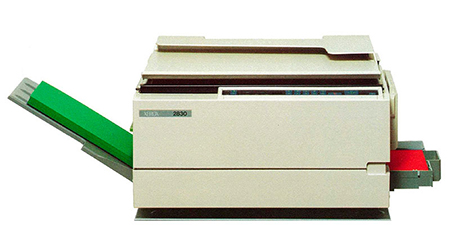
Today’s printers are more compact and versatile, offering features like WiFi connectivity, touchscreen interfaces, and built-in apps that make them easy to use and highly functional.
Xerox remains a leading name in the print industry, known for its innovative products and reliable service.
As a Xerox Platinum Partner, STPT is committed to supporting this tradition of innovation. One of the top Xerox models in 2024, the Xerox VersaLink C415, is a perfect example of modern printing technology. It’s small enough to fit on a desk but powerful enough to handle the demands of a busy office.
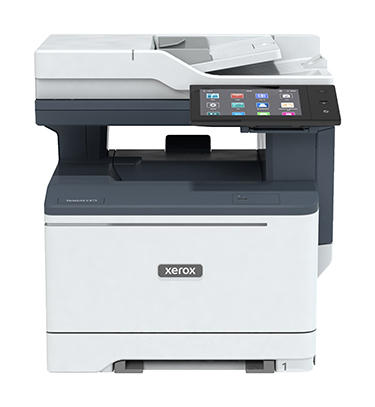
Printing and the Internet: How Are They Connected?
Although printing and the Internet might seem like separate worlds, they’re actually closely linked.
The printing press led to other inventions, like copiers and scanners. In his article The Relationship Between the Printing Press & the Internet, writer Stephen Cooper explains that the computer’s core programming evolved from a mechanical loom that input programmable patterns into punch cards.
Early computers translated programs using punch cards in the 1960s. The government then became interested in the idea of linking computers together, so they used programs similar to that of earlier machines, like the loom, to link different mechanical devices together.
And the Internet was born.
Without these advancements, the technology needed to build computers and create the Internet might never have developed. The printing press made knowledge more accessible, which led to new inventions and innovations, eventually transforming how we communicate and share information globally.
Printing in a Digital World
In today’s digital world, we rely on the Internet for almost everything. We Google questions instead of looking them up in books, type documents instead of writing them by hand, and file taxes online without using a single sheet of paper. But even as paper use declines, printers remain essential.
Printers are more than just paper machines—they help us bridge the gap between digital and physical information. We use them to scan, copy, and fax documents, digitize paper records, and even convert handwritten notes into digital text. And long after the world has gone totally paperless, we will still need to make digital copies of old paper documents.
Modern Multifunction printers, like those from Xerox, offer advanced features that go beyond the standard print, copy, fax and scan functions. Newer Xerox models come with built-in app galleries and control centers. Some of their apps use A.I. technology to automatically redact sensitive information from documents, scan handwritten texts into digital documents.
The Future of Printing: Personalization, Sublimation, and 3D Printing
The future of the print industry is brighter than you may think.
A lot of people have bought into the myth that printing is going the way of the Dodo bird, (which, by the way, may not be extinct for much longer) but the print industry was built on innovation, and it is continuing to innovate.
Despite the shift toward digital, the print industry continues to innovate. Three areas of growth are personalized packaging, sublimation printing, and 3D printing.
Personalized Packaging: Big companies are increasingly using custom packaging to promote their brands. You’ve probably seen Amazon boxes decorated with popular characters or subscription boxes featuring company logos. This trend in branding is only growing, as businesses seek to make a lasting impression on customers.
Sublimation Printing: Sublimation printing is also a subset of merchandising and branding. This technique transfers designs from paper to fabric using heat and pressure. It’s popular for creating personalized items like t-shirts, blankets, and promotional products.
3D Printing: This technology allows users to create physical objects from digital designs. It’s used in various fields, from medical devices to custom art. For example, architects are using 3D printing to create models, while doctors are printing custom medical devices like cochlear implants and braces.
Below is an anatomical model of a hand, with the 'skin' made out of an elastic 3D printing material, courtesy of formlabs.
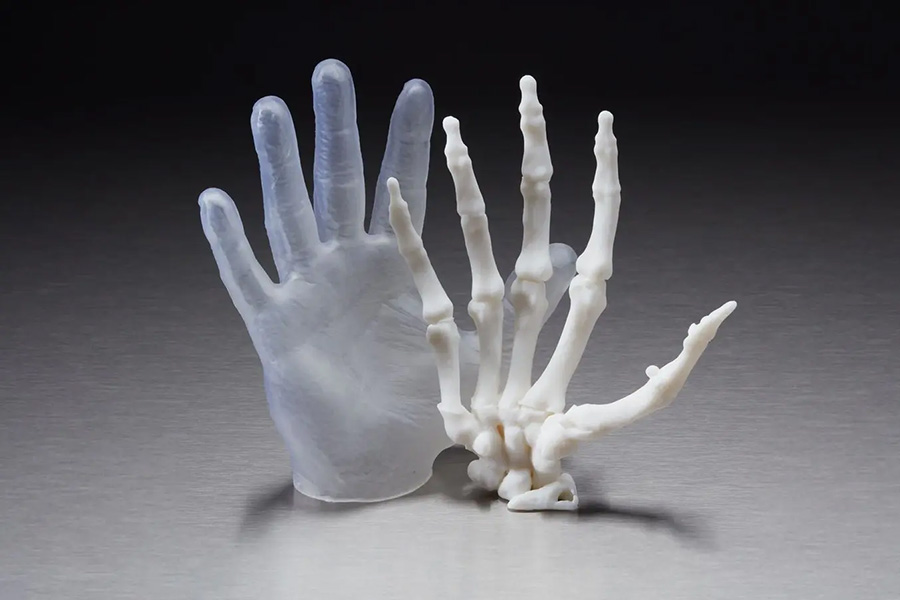
The Printing Industry: A Legacy of Innovation
The history of printing is a story of constant change and innovation. From cave art to laser printers, each development has changed how we share and access information. And the print industry isn’t done evolving. Whether it’s personalized packaging, sublimation, or 3D printing, new technologies continue to push the boundaries of what’s possible.
Looking for a Print Vendor with a Rich History?
For nearly 40 years, STPT has helped North Texas and DFW businesses find the right printing solutions. Our team has over 200 years of combined experience, and we’re dedicated to making the printer-buying process as easy as possible.
If you’re looking for a local print vendor with a proven track record of great service, contact us. Whether you need a new printer or just have questions about the print industry, we’re here to help.
Interested in how the printing industry is evolving today? Discover the top printing trends shaping 2024 and see what’s next for this ever-changing field. Read the 2024 Printing Trends.
